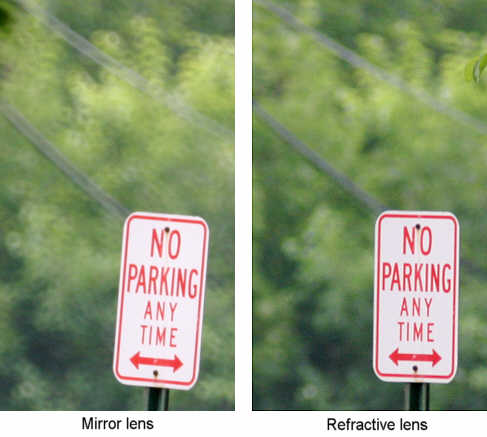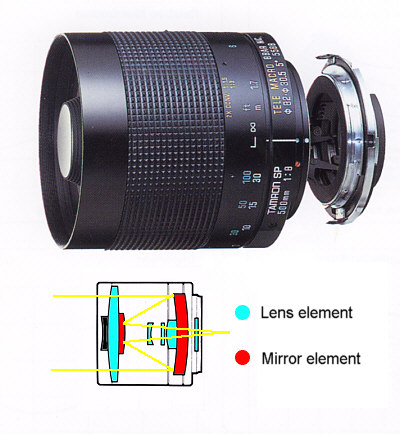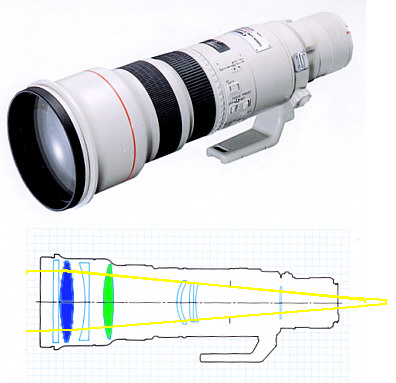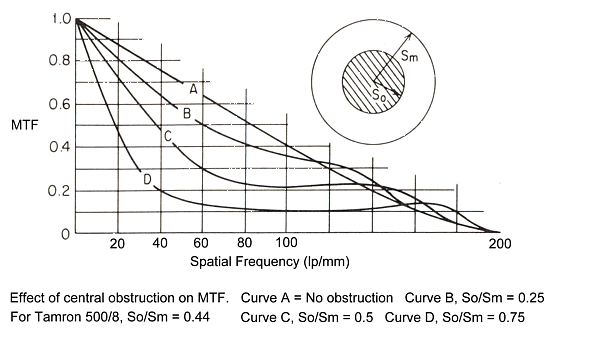
|
Mirror Lenses - how good? Tamron 500/8 SP vs Canon 500/4.5LInspired by Herbert Keppler's praise of 500/8 mirror lenses in the August 2003 issue of "Popular Photography" I thought I'd dig my old Tamron 500/8 mirror lens out of the closet and test its performance against a Canon EF500/4.5 using an EOS 10D 6MP digital DSLR. I wasn't expecting it to do particularly well... TechnicalThese tests were done using a Canon EOS 10D body (6MP). The lenses compared were a Canon EF500/4.5L USM and a Tamron 500/8 mirror lens in a Tamron adaptall mount. A rare and hard to obtain adaptall mount for the Canon EOS was used to mount the Tamron lens on the EOS body. Tamron only made a few, so if you don't have one and you want one, you're probably out of luck. An alternative way to mount an adaptall lens on an EOS body is to get a Pentax Screw Mount (M42) Adaptall mount and an M42 -> EOS lens adapter. A Gitzo 1325 tripod with an Arca-Swiss B1 ball head was used to support the lenses. In each case the lens was used wide open, a nominal f8 for the mirror lens, f4.5 for the Canon. Since my experience with 500mm lenses is that 90% of the time you'll be using them wide open, I think these conditions are appropriate - and for the mirror lens there's no choice anyway!. "Film" speed was set to ISO 800. In previous tests I've established that resolution is essentially unaffected by shooting with the 10D at ISO 800 rather than ISO 100, though of course the noise level is higher. The Lenses
The Tamron 500/8 SP is, of course, a mirror lens - but that doesn't mean it's all done with mirrors. In fact the Tamron lens has, according to their literature, 7 elements in 4 groups, only two of which are mirrors. There is a front corrector lens (which isn't the shape shown in the figure). Most mirror lenses are of either a Schmidt-Cassegrain design or a Maksutov-Cassegrain design. The difference is in the shape of the corrector plate. For the Schmidt it's an aspheric element, for the Maksutov it's a deeply curved spherical meniscus lens. Looking at the Tamron it appears to be a Schmidt. There's not all that much theoretical difference in performance - much depends on how well each design is optimized and built - but the Schmidt is more complex and harder to produce and often (though not always) signifies a better lens. Really cheap mirror lenses tend to be Maksutovs since the corrector plate is cheaper to make and the secondary mirror can be an aluminized spot on the rear of the corrector plate. The additional small lenses are further corrective lenses and field flattening lenses (which are sometimes absent in cheaper designs). So although it's a mirror lens, it has refractive elements too. Theoretically a lens made ONLY of mirrors has no chromatic aberration, but the addition of the corrective lenses required to optimize the image quality could (in principle) introduce small amounts of chromatic aberration. One Tamron catalog I have refers to the 500/8 using a mangin mirror, which is a second surface spherical mirror. Normally mirrors used in optics are first surface, which means the reflective coating is applied to the surface of the mirror and the light never passes through the glass of which the mirror is made. In a second surface mirror the light first passes through the glass, is then reflected from the rear surface and passes through the glass again on the way out. If the glass is of good optical quality, a mangin (2nd surface) mirror can be used to correct for spherical aberration and coma and so one optical component can be used to perform several functions resulting in improved performance with fewer discrete optical components. The Tamron mirrors are also stated to be silver coated, which would give them higher reflectivity for visible light than the more commonly used aluminum mirror coatings.
The Canon EF500/4.5L USM lens is a conventional refractive design using one fluorite element (shown in blue) and one UD glass element (shown in green) to optimize performance and reduce chromatic aberrations. Note the presence of a flat element at the front of the lens. This is to protect the fluorite element which is more susceptible to scratching than conventional glass. Mirror OpticsMirror lenses, by virtue of their central obstruction, will always have somewhat lower contrast than good refractive lenses as the above figure shows. The ratio of the center obstruction to the full aperture for the Tamron lens is about 0.44. This means that at, say, 60 lp/mm the MTF will be about 1/2 that of an unobstructed lens operating at the same f-stop as shown in the figure below. The figure is applicable to any lens operating at f8. Curve A would apply equally to a refractive lens like the Canon RF500/4.5L at f8 or to a mirror lens with no central obstruction operating at f8. The increase in MTF at high spatial frequencies is real, but is of no practical benefit in photography for two reasons. First the drop in MTF at low frequencies will greatly reduce the perceived sharpness of an image. Second, it's at too high a spatial frequency to be of use since the 10D has a resolution limit of <70 lp/mm and even on film it will be lost in the noise.
The out of focus regions of the image will always have that "mirror" look with harsh detail rather than smooth blurring. Both are consequences of basic optics and there's no way around these limitations. The lower contrast is due to the effect of the obstruction on the lens MTF, not due to the use of mirrors as is sometimes suggested. BTW mirror lenses have the same DOF as refractive lenses of the same aperture, despite anything you might read to the contrary on some "less than accurate" websites.
The TestsI used my trusty old resolution test chart from Edmunds Scientific for the testing. As you can see, it's seen better days but it's still effective. Shortly after this test it was caught in a torrential downpour since it was left out in the garden and a thunderstorm caught it (and me) by surprise - it will soon be replaced by a brand new copy!
Above is the field of view of the 500mm lens and 500mm lens + 1.4x Tamron TC. I'm showing this so you can get an idea of where the enlarged segments of the images which are shown below were taken from. The red squares show the approximate locations of the samples. In each case below the Tamron 500/8 mirror lens sample is on the left and the Canon EF500/4.5L sample is on the right, Note: All the image presented below are directly from the camera. No sharpening or other manipulation has been done, other than cropping unless otherwise noted The Results
Well, here's a bit of a surprise. Not all THAT much difference. Sure the Canon lens is better but not by as much as you'd expect. Now I KNOW for sure that the Canon lens is very, very sharp. In fact 500mm lenses don't come any sharper. What we're seeing here is something of the limits of digital resolution. The 10D sensor just can't resolve more than about 60 lp/mm - and before you suggest the same test using a 1Ds, remember that the pixel DENSITY (hence resolution) is higher on a 10D than a 1Ds - the 1Ds just more pixels but they are spread over a wider field, so the 1Ds pixel pitch is actually larger (8.8 microns on the 1Ds vs. 7.4 microns on the 10D).
In this case the difference is quite a bit more significant. The Canon lens is sharper, no doubt about it. Note that we're not all the way out to the corner either. So now let's add a 1.4xTC and see what happens
Actually the first thing that happens is that the Tamron lens and 1.4x TC won't work on the 10D! Manual focus lens mounts (and lens adapters) are different from AF mounts in that they don't contact a microswitch in the lens mount of the 10D (or any EOS body) which tells the camera to look for an AF lens. The Tamron TC is autofocus, so it trips this microswitch, which is fine as long as you then attach and AF lens. If you attach a manual focus lens, the body still looks for an AF lens and when it doesn't find one it generates an error condition. The solution is to rotate the Tamron TC slightly so it's not locked into place. This untrips the microswitch and all is well with MF lenses. Just beware of the lens accidentally falling off! When it comes to performance, again we can see the Canon lens is clearly better. Not a big surprise. A bigger surprise is that the mirror lens holds up as well as it does.
Well, not much difference here. Both show some chromatic aberration, probably due to the TC as much as the lens. The Canon less is very well chromatically corrected and the mirror lens should have no intrinsic chromatic aberration. Though the Canon lens is at f4.5, and so would be expected to show more background blur than the 500mm f8 lens, this is still a valid comparison since normally you'd be shooting with the 500mm lens wide open.
Here we have a clear, no doubt, hands down winner, just as we would expect. The mirror lens produces a very confused background with lots of false detail due to effect of the central obstruction inherent in the design of all photographic mirror lenses. The conventional refractive lens produced a much smoother out of focus region. Below is a second example showing the less pleasing bokeh that mirror lenses produce on certain backgrounds. 
MacroThe Tamron focus down to 1.7m (1:3) while the Canon only focuses to 5m (1:9) - however performance does drop when the Tamron is used in the Macro mode, thought it may still be acceptable. It's also fixed at f8, so you can't stop down for more DOF and you have the typical mirror lens "bokeh" (distracting background blur) to contend with - though note that it's not too much of a problem in the image below. It really depends on the nature (and distance) of the background, and for some macro shots the "background" may be close and so only slightly blurred. Though a mirror lens ins't an ideal macro lens since you have fixed aperture and can't stop down for DOF, it's nevertheless quite useful in some situations. Getting the EF500/4.5L to focus down to 1.7m would need an awful lot of extension tubes!
Other StuffThe Tamron lens does seem to have one interesting property, and that's that maybe you can get away with shooting (static subjects) at slow shutter speeds with the lens on a tripod without using MLU (Mirror Lock Up)and/or a remote release. The lower mass of the lens and the smaller size makes it less susceptible to "wobble" induced by shaky hands! In a test I took 4 images at 1/4s shutter speed. Both the Tamron mirror lens shots were sharp. One of the Canon shots was almost as sharp, but one was clearly blurred by camera induced movement. Maybe I could have used ISO 100 instead of ISO 800 for all these tests and shot everything at 1/8s instead of 1/60s! I think one reason for this behavior is that with the Tamron 500/8 you can (indeed have to) mount the camera on the tripod rather than the lens. With the EF 500/4.5L you have to mount the lens on the tripod, which puts the camera body about 9" from the pivot point of the (locked down) ballhead. Now if you push left or right on the camera with, say, 1lb of force and it's 9" from the support point you put 0.75 ft-lbs of torque on the system and you get quite a deflection. When you let go that stored energy appears in the form of vibrations. If you push with the same amount of force on the camera and the camera is directly over the (locked down) support point, you put no torque on the support and the deflection is zero.When you let go, nothing much happens. If you bang the end of the EF500/4.5L you'll see the shake through the viewfinder go on for a second or so. If you bang the end of the 500/8 you won't see any shake at all (except maybe from the direct impact if you hit it hard enough!). Note that this is on a Gitzo 1325 Carbon fiber tripod (legs not extended) and using an Arca-Swiss B-1 ball head, so the tripod support isn't by any means flimsy.
Verdict?I declare the Canon EF500/4L the winner!! However keep in mind that the price of a new Tamron 500/8 lens is $400, while a used Canon EF500/4.5L will probably cost you around $3000 - and its replacement, a new EF500/4L IS, will cost you at least double that. The Tamron weighs about 19oz, while the 500/4.5L weighs 6.6lbs and the 500/4L IS weighs about 8.5lbs. The 500/4L IS and 400/4.5L are just over 15" long, while the Tamron 500/8 is about 3.6" long. The Tamron gives you 1:3 macro, the Canon 1:9. The Canon lens is also autofocus and f4.5. The Tamron lens is manual focus and nominally f8, though closer to f9 in practice. That's two stops plus AF - a huge advantage for the Canon lens in practical field use. In fact to shoot the images above I used ISO 800 in order to keep shutter speeds up above 1/60s with the Tamron lens to make sure that sharpness wasn't affected by camera movement (though this might not have been necessary in light of the observations above - but it never hurts to be safe). Focusing on the Tamron 500/8 mirror lens is very smooth, but very sensitive. You're also at f8, so the viewfinder isn't as bright and the extra DOF makes deciding when something is in focus a bit tricky. You have to rock focus back and forth a few times to make sure you've got good focus. You need a pretty delicate touch to optimize focus. If your subject is moving you're probably going to have a tough time tracking it with focus, in fact I'd go as far as to say that attempting to track a moving subject with a manual focus 500mm mirror lens is pretty much doomed to failure. Even following focus a bird hopping around or an animal grazing and constantly moving it's head could be tricky. Forget about flying birds. The Canon lens also has a rotating tripod collar, so it's much easier to rapidly switch from horizontal to vertical format than with the Tamron 500/8 lens which doesn't have a tripod collar and so is supported on the camera. Some mirror lenses (but not the cheap ones!), do have a rotating tripod collar So how much of the apparent equality in optical performance is due to the use of digital rather than film? Probably quite a bit, however if you are shooting digital you probably won't care, since digital performance is what you are interested in. I've previously tested these lenses using Velvia and I saw a greater difference (obviously with the Canon lens still being the winner!). Should you buy a mirror lens?Well I used to say no, it's not a good idea. I still don't think they are great, but based on this test I'd say that if you're shooting with a 10D and your budget is limited, a mirror lens might be worth considering. However note that a $60 "no-name" mirror lens may be significantly worse than a $400 Tamron 500/8 SP which does have a reputation of being one of the better mirror lenses. The Nikon 500/8 is reputed to be even better, but the gray version currently sells for $630 and the US version for $860, which makes it less attractive. I suspect the Contax Zeiss Mirotar T*500/8, which has a street price around $1800, is better still. Even in mirror lenses, you usually get what you pay for. For not all that much more than the price of these "better" mirror lenses (and significantly less than the Contax) there are a number of conventional 500mm lenses available, such as the Sigma 50-500 ($900) and 170-500 ($600), which not only give you zoom capability, but autofocus and aperture control as well, in addition to a stop or so of extra speed. The manual focus fixed-aperture mirror lens can't be beaten on size, weight or cost, but it's certainly second in terms of convenience and overall performance when compared to autofocus refractive lenses with variable aperture. If I was going to attempt to climb Mt Everest or run a marathon carrying a 500mm lens, I'd go for a mirror. If I was planning to visit Yellowstone in the fall, I'd still drag my EF500/4.5L along with me. On a limited budget, it's a tough call. A mirror lens may be the best you can do if you really need 500mm and you only have a few hundred dollars to spend. There are under $200 500mm f8 refractive lenses sold. These are usually fairly simple 4 element lens designs. None of the major lens manufacturers make them, but they show up from time to time under "house brands" or names you don't recognize. Again it's a 500mm lens and it costs under $200. Don't expect miracles. They are usually much longer than a mirror lens and their optical performance isn't great, so whether you go for a cheap mirror lens or a cheap refractive lens is more a matter of convenience than optics. The other thing to consider is whether you actually need 500mm? If you're shooting with a 10D, a 500mm lens will give you the same field of view as an 800mm lens on a full frame 35mm camera (due the the 1.6x "multiplying" factor - which is really a 1,6x cropping factor). An 800mm lens is pretty long - in fact longer than most serious full frame 35mm nature photographers use.. A 300mm lens on a 10D gives the same field of view as a 480mm lens on a full frame 35mm camera and makes a very good general purpose telephoto. You can get 100-300 zooms, or if you want the ultimate, a 300/4L IS lens. With 1.4x TC a 300mm on a 10D gives you the equivalent view of a 672mm lens on a full frame 35mm camera. Something to think about anyway.
Which Mirror Lens?Well, that depends on your budget and which camera you are using. If you really want a mirror lens, here are a few choices:
You can also search for a used Tamron 500/8 (or other 500mm mirror lens) on eBay using the search box below:
© Copyright Bob Atkins All Rights Reserved |
|||||||||||||||||||||||||||


